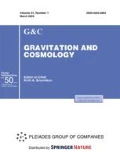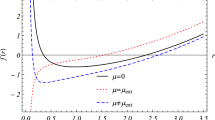Abstract
Geodesic completeness needs that near the horizon of a black hole there exist “white hole” geodesics, coming from the region inside the horizon. We give a classification of all such geodesics with energies E/m ≤ 1 for the Schwarzschild and Kerr black holes. Collisions of particles moving along the “white hole” geodesics with those moving along “black hole” geodesics are considered. Formulas for the increase in the energy of collision in the centre of mass frame are obtained, and the possibility of observation of high energy particles arriving from a black hole on the Earth is discussed.
Similar content being viewed by others
References
L. D. Landau and E. M. Lifshitz, The Classical Theory of Fields (Pergamon Press, Oxford, 1987).
S. Chandrasekhar, The Mathematical Theory of Black Holes (Oxford Univ. Press, Oxford, 1983).
A. A. Grib, Yu. V. Pavlov, and V. D. Vertogradov, Mod. Phys. Lett. A 29, 1450110 (2014).
M. Banados, J. Silk, and S. M. West, Phys. Rev. Lett. 103, 111102 (2009).
A. A. Grib and Yu. V. Pavlov, JETP Lett. 92, 125 (2010).
A. A. Grib and Yu. V. Pavlov, Astropart. Phys. 34, 581 (2011).
A. A. Grib and Yu. V. Pavlov, Grav. Cosmol. 17, 42 (2011).
A. A. Grib, Yu. V. Pavlov, and O. F. Piattella, Int. J. Mod. Phys. A 26, 3856 (2011).
A. A. Grib, Yu. V. Pavlov, and O. F. Piattella, Grav. Cosmol. 18, 70 (2012).
A. A. Grib and Yu. V. Pavlov, Theor. Math. Phys. 176, 881 (2013).
A. A. Grib and Yu. V. Pavlov, EPL 101, 20004 (2013).
A. A. Grib and Yu. V. Pavlov, Int. J. Mod. Phys. D 20, 675 (2011).
R. P. Kerr, Phys. Rev. Lett. 11, 237 (1963).
R. H. Boyern and R. W. Lindquist, J. Math. Phys. 8, 265 (1967).
V. P. Frolov and I. D. Novikov, Black Hole Physics: Basic Concepts and New Developments (Kluwer Acad. Publ., Dordrecht, 1998).
J. M. Bardeen, W. H. Press, and S. A. Teukolsky, Astrophys. J. 178, (1972) 347.
T. Harada, and Kimura, Phys. Rev. D 83, 084041 (2011).
O. B. Zaslavskii, Phys. Rev. D 84, 024007 (2011).
A. A. Grib and Yu. V. Pavlov, Mod. Phys. Lett. A 23, 1151 (2008).
J. Gariel, N. O. Santos, and J. Silk, Phys. Rev. D 90, 063505 (2014).
Author information
Authors and Affiliations
Corresponding author
Additional information
Based on a plenary talk given at the 15th Russian Gravitational Conference—International Conference on Gravitation, Cosmology and Astrophysics (RUSGRAV-15), June 30–July 5, 2014, Kazan, Russia.
Rights and permissions
About this article
Cite this article
Grib, A.A., Pavlov, Y.V. Are black holes totally black?. Gravit. Cosmol. 21, 13–18 (2015). https://doi.org/10.1134/S0202289315010065
Received:
Published:
Issue Date:
DOI: https://doi.org/10.1134/S0202289315010065



